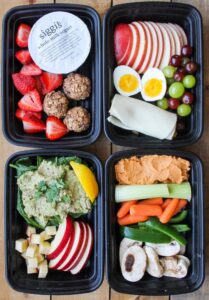 5 Tips for Healthy Snacking for Families
5 Tips for Healthy Snacking for Families
Snacks are defined as “a small amount of food eaten between meals.” March is National Nutrition Month. It is important to address the impact of snacks on children’s overall health in their developmental stages. Obesity in children and adolescents has been an increasing problem over the years and is currently still a problem and parents play an essential role in ensuring children create healthy habits with snacks. According to the CDC, “Obesity prevalence was 12.7% among 2 to 5 years, 20.7% among 6 to 11 years old, and 22.2% among 12 to 19 years old.” Establishing a healthy relationship early on with food in a child’s developmental stages sets them up to develop healthier habits in adulthood.
Tip One: Substitute
- Parents can substitute unhealthy snacks like; regular potato chips, pretzels, chocolate chip cookies, and pringles for fruits. Those snacks lacks vitamins and nutrition that is essential for daily health.
- Healthy snacks that parents can implement are; apples, carrots, strawberries, bananas, and oranges.
- There is a lot of benefit to substituting unhealthy snacks for healthy snacks. Fruits and vegetables have a lot of vitamins that aid in children’s mental and physical growth. Some fruits and vegetables provide fiber, antioxidants, vitamin k, vitamin c, iron, support eye health, and so many more that can help children’s growing bodies.
Tip Two: Make Things Interesting
- A great way to adopt healthy snacking in the home is by making things interesting for children. Making funny faces on their plate helps children get excited about eating fruits and vegetables.
- Converting fruits and veggies into a smoothie for a snack is an excellent way that children can get all the benefits fruits and vegetables contains.
Tip Three: Structure Eating Occasions
- It is essential to establish snacking time for children. Having a snacking time prevents children from excessively eating throughout the day.
Tip Four: Get Them Involved
- Getting children involved in choosing their healthy snacks creates healthy decision-making.
- Involving your child in cutting and preparing healthy snacks makes them excited to eat the fruits/vegetables during snack time.
Tip Five: Encourage Mindful Eating
- Keeping children away from the TV and playing games on phones/tablets can lead to overeating due to distraction. So children need to have that break away from technology while eating to get familiarized with food texture, taste, and smell.
Resources
CDC. (2020a, February 24). Mealtime Routines and Tips. Centers for Disease Control and Prevention. https://www.cdc.gov/nutrition/InfantandToddlerNutrition/mealtime/mealtime-routines-and-tips.html
CDC. (2020b, October 31). Tips to Help Your Picky Eater. Centers for Disease Control and Prevention. https://www.cdc.gov/nccdphp/dnpao/features/picky-eaters/index.html
CDC. (2022, May 17). Childhood obesity facts. CDC. https://www.cdc.gov/obesity/data/childhood.html
How to Use Fruits and Vegetables to Help Manage Your Weight. (2020). Centers for Disease Control and Prevention. https://www.cdc.gov/healthyweight/healthy_eating/fruits_vegetables.html
Preschoolers | MyPlate. (n.d.). Www.myplate.gov. https://www.myplate.gov/life-stages/preschoolers





